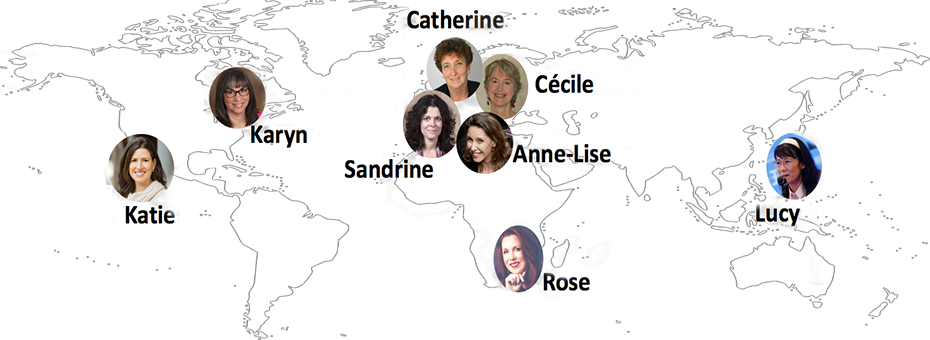(This article was primarily authored by Catherine Chabiron, with input and support from the Lean Sensei Women. The Lean Sensei Women are a group of experienced lean practitioners who take turns to discuss business and world topics with lean lenses.)
As the lockdown impacts four billion people over the planet, we are also facing an increasing risk of losing millions of jobs. We need to protect people, and, at the same time, use our creativity to come up with innovative ideas to maintain a minimum of business continuity and restart the economy in the best conditions.
Companies face risks on a number of topics that had previously been perceived as under control. How can we protect our employees from an invisible threat? How can we keep our focus on customers when worrying about the company’s future? How do we secure whatever is left of our production?
TPS can help us think about how we will accept this challenge and rebuild for the future. More than ever, good products and services, today and tomorrow, will come from good thinking.
***
How do we consolidate trust and provide basic stability for our employees?

Employees, customers, suppliers are all human beings, dealing with a very human challenge. We are largely blocked from the social compensations we usually enjoy, with kids at home or aged parents far away, and possibly grieving the loss of relatives or friends. We are stressed.
Some governments around the world are offering exceptional allowances for unemployment, and paying salaries during the lockdown. The CEO of a digital marketing company, JVWEB, has however decided he would reject the offer and rather bet on the future: although the turnover has been reduced by 50%, he has all his employees focused on learning and kaizen. He plans on using government cash facilities rather than unemployment allowances to keep them at work and part of the same team. Competence and morale, he says, are crucial.
Employees can’t work properly if they are not duly equipped and protected. The issue is sustaining this new practice over time. How do we fight habituation?
The French Lean Institute is suggesting 5S on sanitizing as a possible approach, a topic recently addressed by Michael Balle. 5S is a local team kaizen activity on workstations and work environment, and the best way to sustain sanitizing is to ask teams to take over the approach in their own area of work.
How can we address the possible increasing gap between support functions who are working safely from home, and production and supply chain fighting the daily war in the trenches?
Now is an opportunity to ask support functions to work on enabling solutions for frontline workers that will help them win daily safety and supply fights. A company in the food business, Sodebo, has developed a weekly information to relate all kaizen initiatives geared on enabling business continuity, customer satisfaction AND employee protection. An engineering office in PCM HabilClass is helping an operator to design a new ergonomic welding workstation, to adjust the production capacity to new customer needs, while reducing the handling time and effort.
***
How do we protect our customers?
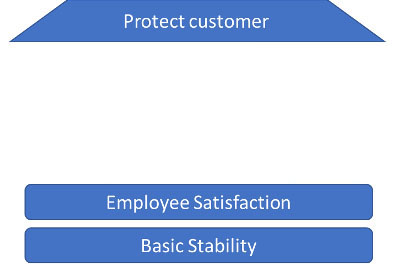
Aramisauto.com, an online car seller is now delivering cars directly to the customer’s home address, as outlets have been closed. Employees are generating many creative ideas allowing the customer to sign the paper or take over the car with no virus transmission risk.
Recently, one of our Lean Sensei Women group was speaking with a leader in charge of designing Tesco’ssupermarket stores of the future: they are already starting to change their design to account for new constraints like extreme hygiene and contact-less activities. All public places will have to do the same.
Do our customers have new problems that we can help them with? How can we adapt our products or services to solve customers’ immediate needs?
PCM HabilClass, a lean company who was previously manufacturing trolleys to carry patient administrative files in hospitals has shifted its production to inox trolleys that contain and carry hospital supplies in the new Covid-19 wards. And feedback on usage is immediately used as an opportunity to improve the design.
***
How do we strengthen our supply chain?
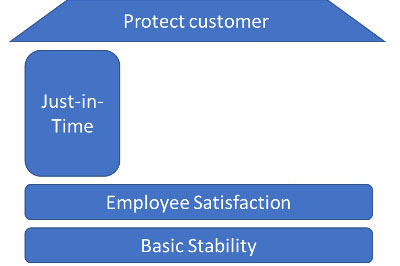
The coronavirus crisis is offering many examples of failing supply chains: too complex, spread over different countries, suffering from excessive lead times. When suppliers are seen as mere providers, they react poorly to demand swings.
Have we secured the supply chain on our most critical products?
Lean companies are still up and running because they have developed frequent local deliveries which are supported by strong partnerships. The lean leader of PCM HabilClass bought his company only a month before the crisis and found his supply chain not to be equal to the game. The local transporter who managed to find a slot in one of his milk runs, the supplier who found him substitute parts, when his main supplier could not, are now very probable partners for his supply chain. And his engineering team has learned that very specific, unusual parts, while looking great at the design stage, may be the weakest link on the path to a successful new product.
Did we test the flexibility of our production lines?
Every day we hear of countless examples of companies temporarily shifting their manufacturing lines and competencies to the production of masks, sanitation gels, respirators. Yet shifting production overnight is not obvious.
Small sized companies in the textile industry have reconfigured themselves to produce masks because the workers quickly learned how to make seams in different shapes. In contrast, a large paper tissue company, that had the raw material and was eager to do the same, found that their automated lines were not reconfigurable.
Sodebo saw customers move away from individual salad bowls and massively turn to family size pizzas. The capacity to switch over and train resources overnight was key. Lean teaches us to build flexible lines and develop polyvalence.
Have we reflected upon maintenance and the issues a long lockdown will likely generate?
Think of all the machines, lines and transportation means that have been stopped. A lean transportation executive in French railways is challenging us: idle equipment deteriorates (drying seals, particle deposition, rust) and you can expect peaks of maintenance when the economy restarts. How do you level the effort and organize smaller batches of running and stopping equipment?
***
How do we manage quality remotely?
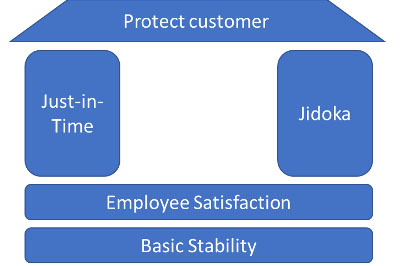
If employees work from home, how are we rethinking communications channels? Are they adapted to the need?
Group chats can work well within a community of practice to exchange tips and tricks (but also fears and emotions), but electronic whiteboards or sharing pictures and data via video-conferences remain the next best thing to solving problems in the gemba.
Task assignment tools, largely used in software development, are great as long as you can talk to people around to understand what is going on, but we see instances in digital teams working from home, where management is unable to sort out priorities just looking at those tools. There is consequently a risk that feature output (quantity) overtakes outcome (value). One of us, Sandrine, is pushing to revive Kanban as a visual tool to show what we are delivering to customers…or not.
How are we ensuring that each and every frontline operator knows to whom they should come and ask for help?
The usual team leader or manager may not be available. Missing links in management support chains are particularly needed for the new problems revealed by the crisis:
- Safety and sanitation
- Supply chain failures
- Resource flexibility and polyvalence
- Changing regulations
How do we sustain kaizen in such a period?
Turnover is down, time is available, and kaizen is a great opportunity to fight stress and concerns, while building something positive together. All the lean companies we know ensure that kaizen and training continue. Toyota has always extensively developed kaizen during crises, particularly targeting waste, scrap, non-quality elimination so as to restart with a sounder cost base.
***
How do we prepare for the future?
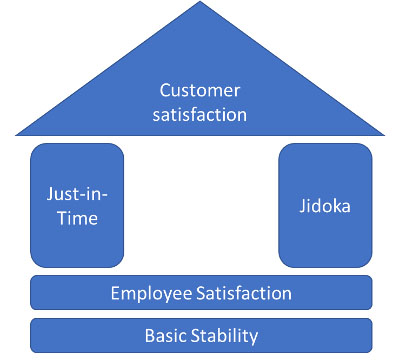
Some companies are really hurt by the lockdown. Their customers have stopped buying, but will buy again, when conditions are back. The exit conditions from the crisis are unknown today, but now is the time to think about the future and prepare for it.
There is a risk, in such an unheard-of crisis, that old command & control or financial management tricks will prevail:
- Buy and build huge stocks of things critical today, but possibly obsolete tomorrow, instead of designing a just-in-time flow
- Take advantage of the crisis to do a bit of severe cost-cutting on the sly
- Accelerate automation since humans proved terribly fallible in the pandemic
- Defer actions to protect our natural resources until lost profitability is recovered
Lean is about learning new situations and developing solutions for the value stream. TWI (Training Within Industry) actually came out of needing to train all the women and senior workers who stepped up and moved into the factories in WWII. Toyota has experienced many crises. Each time, they used it as an opportunity to build capability and get ready for recovery. That is why the system gets stronger over time. We believe TPS (also known as in Thinking People System) is a solid basis from which to build anew.
———-
AUTHOR BIO: LEAN SENSEI WOMEN
Coming from different continents, horizons and professions, the individuals who form Lean Sensei Women are all recognized lean Senseis, who help companies and organizations build sustainable growth through lean management. They believe in the development of people, respectful of both teams and environment, with a view to produce more value for customers and to society.
Catherine Chabiron: Board Member, Institut Lean France. Author of Notes from the Gemba in Planet Lean and executive lean coach.
Rose Heathcote: Author of Clear Direction and Making a Difference. Rose is personally dedicated to transformation in Africa, bringing change to organisations for the benefit of employees, customers, shareholders and the environment.
Lucy Liu: Lean leadership and organizational transformation coach with 28 years of working experience with Toyota Australia, starting at the shopfloor and including leading TPS office and manufacturing capability development. Author of Building An Organizational Learn Architecture for Strategic Renewal.
Sandrine Olivencia: Lean sensei and member of Institut Lean France. Specialist in Obeya and product development expert for the digital world.
Cécile Roche: Lean sensei, member of the Institut Lean France, Lean Director of the Thales Group, and author of several books, in particular on Lean in Engineering.
Anne Lise Seltzer: Member of Institut Lean France. Lean Coach in Services and Support functions. Trainer for Lean & Learn at SOL France (learning organization).
Katie Anderson: Katie Anderson is a lean leadership coach and performance improvement specialist with over 15 years of experience. Katie is passionate about developing people’s leadership, problem solving and coaching capabilities to support continuous improvement and organizational transformation.
Karyn Ross: An author of five books including The Toyota Way to Service Excellence: A Lean Coaching Workbook, Karyn is an artist and coach on a mission to “Help People Improve the World”.
